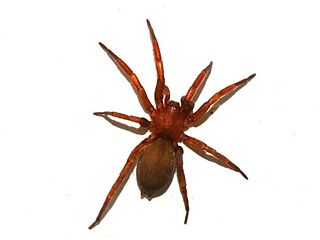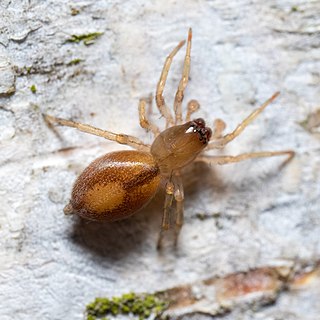
Xysticus is a genus of ground crab spiders described by C. L. Koch in 1835, belonging to the order Araneae, family Thomisidae. The genus name is derived from the Ancient Greek root xyst, meaning "scraped, scraper".

Pellenes is a genus of jumping spiders that was first described by Eugène Louis Simon in 1876. It is considered a senior synonym of Hyllothyene.

Salticus is a genus of the family Salticidae. Salticus is the type genus for the family Salticidae.

Alopecosa is a spider genus in the family Lycosidae, with about 160 species. They have a largely Eurasian distribution, although some species are found in North Africa and North America.
Ozyptila is a genus of crab spiders that was first described by Eugène Louis Simon in 1864. It has been misspelled as "Oxyptila" in multiple accounts.

Enoplognatha is a genus of comb-footed spiders that was first described by P. Pavesi in 1880. They have both a large colulus and a subspherical abdomen. Males usually have enlarged chelicerae. It is considered a senior synonym of Symopagia.

Zelotes is a genus of ground spiders that was first described by J. Gistel in 1848.

Walckenaeria is a genus of dwarf spiders that was first described by John Blackwall in 1833. It is a senior synonym of Paragonatium, as well as Wideria, Cornicularia, Prosopotheca, Tigellinus, and Trachynella.

Gnaphosa is a genus of ground spiders that was first described by Pierre André Latreille in 1804. They all have a serrated keel on the retromargin of each chelicera.

Micaria is a genus of ground spiders that was first described by Niklas Westring in 1851. They are 1.3 to 6.5 millimetres long.

Haplodrassus is a genus of ground spiders that was first described by R. V. Chamberlin in 1922. They range from 3 to 10 millimetres. H. signifer is the most widespread species, found across North America except for Alaska and northern Canada.

Centromerus is a genus of dwarf spiders that was first described by David B. Hirst in 1886.
Rhysodromus is a genus of spiders in the family Philodromidae. It was first described in 1965 by Schick. As of 2022, it contains 28 species.

Porrhoclubiona is a genus of sac spiders that was first described as a subgenus of Clubiona by H. Lohmander in 1944. Clubiona is a polyphyletic group that has been divided and reorganized many times, and whether this genus is a synonym of Clubiona or an independent genus is still under debate.
Spiracme is a genus of crab spiders erected by Anton Menge in 1876 to contain S. striata, transferred from Xysticus. The exact relationship of these spiders and their closest relatives has been long debated, and many included species have been transferred to and from similar genera, namely Xysticus and Ozyptila. Most recently, Rainer Breitling conducted a DNA barcoding study in 2019 and grouped similar species based on the results:












